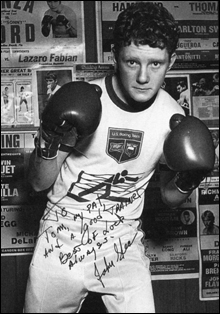If Shea’s story begins on the hardscrabble alphabetized streets off Broadway, Nee’s begins on a dirt road in Rosmuc, County Galway. “I remember the farm we lived on,” he says, speaking almost as if he were reciting a poem. “Very small. It was nice. A loving atmosphere. Crowded. A lot of people in a small house. Fireplace. Kerosene lanterns. Well water. Home cooking. Made your own clothes.” (He’s less sentimental in his book: “Our family had it tough in Ireland, sure, but I’m not going to tell you any of that Angela’s Ashes crap to try to gain your sympathy.”)
When Nee was eight, after his father had come stateside and saved up enough money to send for his family, he moved with his mother and siblings to South Boston. “Southie was a good neighborhood,” he says. “Unfortunately, it was also home to a high concentration of waterfront thieves. And I gravitated toward them.”
Booze and smokes. Gillette razors. Tuna and crabmeat from Japan. Nee and his buddies would heist them and sell ’em on the streets. He clarifies: “They weren’t like Whitey and Stevie, these guys. They didn’t bully the neighborhood, they didn’t take money off people. They stole off the docks, but that was always considered a fairly honorable profession.”
After a stint in the Marines — a tour in country during the escalating years of Vietnam — Nee came home in the mid ’60s and got a job at the Globe. He got canned for roughing up a shop foreman who mistreated the Irish immigrants there, and it wasn’t long before he returned to his old ways. And soon enough he found himself in the middle of a turf war between the Mullens — the gang of thieves he ran with — and the Killeens, Southie’s ruling criminal class, whose enforcer was a guy named James Bulger. Nee was having a drink with Whitey when the first shots went down. They rode together to the battle, shook hands, and then went their separate ways.
“I said, ‘I guess I won’t be seeing you again.’ ” Actually, he would, through a rifle’s sight. Nee came close to killing Bulger twice, he says, and Whitey tried to return the favor.
But in 1972, after bodies had piled up on both sides, a truce was called. “We decided to end it all and go into business together,” says Nee. “Booking. Horses. Dogs. Numbers. A little bit of shylock — nothing really big.” He writes, “Whitey and I were now officially partners, and nobody at that table could have ever possibly imagined how this treacherous fuck would treat his partners.”
The old war
 By this time, Nee had other concerns. The Troubles in Northern Ireland had been flaming since 1969, and he took the news reports about civil-rights violations against Catholics to heart. Even in an Irish bastion like South Boston, he had a more visceral connection to the Auld Sod than most, and he decided that this was a struggle he could do something to help. In a way, Nee saw it as a sort of constructive redemption for the aimless criminal life he’d led thus far. “I felt I had an obligation. It sounds corny, but an ancestral obligation. That if I could do something, I’d do it.” He went with what he knew: stolen money and weapons.
By this time, Nee had other concerns. The Troubles in Northern Ireland had been flaming since 1969, and he took the news reports about civil-rights violations against Catholics to heart. Even in an Irish bastion like South Boston, he had a more visceral connection to the Auld Sod than most, and he decided that this was a struggle he could do something to help. In a way, Nee saw it as a sort of constructive redemption for the aimless criminal life he’d led thus far. “I felt I had an obligation. It sounds corny, but an ancestral obligation. That if I could do something, I’d do it.” He went with what he knew: stolen money and weapons.